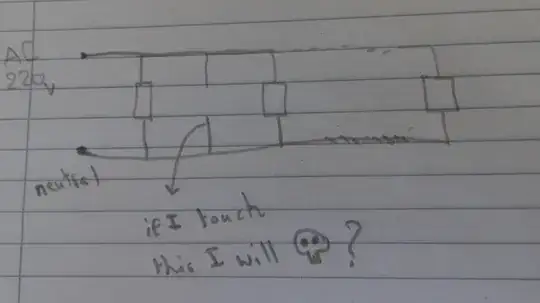this is supposed to represent a house wall outlet. I think it should be yes because adding a resistance between neutral and the ground will make a potential difference between them.
-
1Where is earth in this schematic? Is the resistance between neutral and ground you are referring to, you? – Klas-Kenny Sep 05 '23 at 09:26
-
yes.... I am standing on ground – Majd Sep 05 '23 at 09:28
-
2Does this answer your question: https://electronics.stackexchange.com/questions/76726/is-the-neutral-wire-considered-safe – nanash1 Sep 05 '23 at 09:29
-
yes it did , thanks – Majd Sep 05 '23 at 09:33
-
1If you have a ground fault circuit interrupter, it's possible that it won't be lethal. But don't get me wrong, it's definitely not safe. – Velvet Sep 05 '23 at 09:33
2 Answers
If it were a good installation done to modern practices then you wouldn't die because, neutral is connected to earth in many installations and, this means that the neutral-to-earth voltage is only going to be a few volts. Added to this are the use of residual current circuit breakers (RCD in the UK and GFCI in the US) and these devices will trip the supply when there is a current of around 3 mA to 30 mA imbalance between that flowing in the live wire and that flowing in neutral.
That's the theory but, in practice there are some really bad situations where neutral and live wires swap over and, you can't be sure whether you are touching live or neutral. The residual current device will come to the rescue but, not all installations have this facility (especially in poorer countries).
So, my advice is don't do it.
adding a resistance between neutral and the ground will make a potential difference between them.
Adding resistance can only lower any existing potential difference and, it certainly doesn't create a potential difference.
- 456,226
- 28
- 367
- 807
I think it should be yes
Assuming the wiring has been done correctly and nothing is damaged, the answer is no, you will not die. What makes a neutral a neutral (at least in the US) is that it is bonded (i.e. permanently connected) to ground. So, as long as that bond is intact, the potential of a neutral wire is very near that of the ground.
because adding a resistance between neutral and the ground will make a potential difference between them.
When people warn about the danger of having a resistance between neutral and ground, they are referring to a situation where there is such a resistance instead of a proper bond between neutral and ground. An example might be a damaged (or completely broken) neutral wire.
When a large resistance (i.e. you) is in parallel with a much smaller resistance (i.e. a wire), the total resistance is very close to the resistance of the smaller individual resistance (i.e. the wire). You touching the neutral wire is, "adding a resistance between neutral and ground", but it is adding a resistance in parallel with the bond. So you touching the neutral wire does not add any potential between the neutral and ground.
The danger is that there may be no connection, or a poor connection between neutral and ground existing independently of you touching neutral. Then there could be a potential between neutral and ground independently of your touching neutral. That could result in a shock!
Advice from another answer "Don't do it", is good advice. Assuming that everything is wired correctly, that there are no faults, and that you will touch the right wire and not the wrong wire, is, well assuming something that might not be true. If you are wrong in your assumptions, the result could be fatal. So, don't assume those things, and stay alive.
- 23,260
- 4
- 21
- 75
